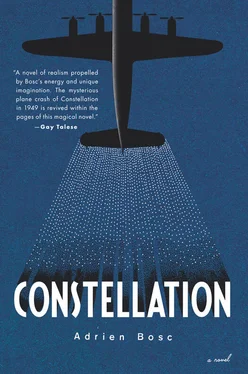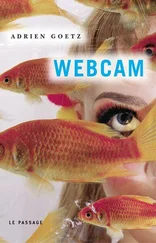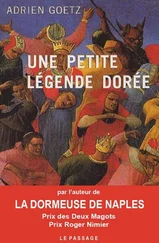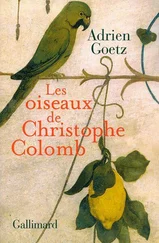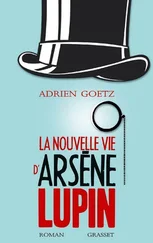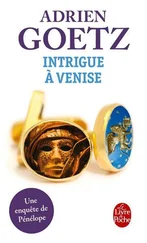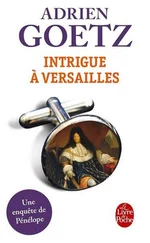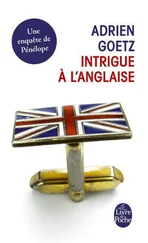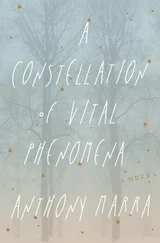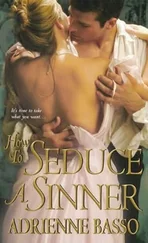
Thirty-three years later, on Wednesday, June 30, 1982, at 10:30 p.m., live on Antenne 2 television from studio 15 at the Buttes-Chaumont, Jacques Chancel devotes a broadcast of his show, Le Grand Échiquier (The great chessboard), to Étienne Vatelot. The episode is called “The âme or soul of the violin.” The violin maker is joined by his friends and clients Isaac Stern and Mstislav Rostropovich. A few days before the show airs, Chancel receives a letter from the pianist Bernard Ringeissen: “I have a priceless gift for you, one that you can present live on television.” After talking to him on the telephone, Jacques Chancel invites him to join the broadcast. In the second half of the show, the host asks Étienne Vatelot to talk about the violinist Ginette Neveu.

JACQUES CHANCEL: This touches you directly, since you were originally meant to be on that airplane.
ÉTIENNE VATELOT: Yes, of course, it gives me a pang whenever I think of her, but I think of her because she was a very, very great violinist, and above all a woman whose temperament was very deep, broad, and open. It’s strange because when Ginette Neveu had this accident, and when the plane had this accident in the Azores, they brought back to us in the workshop the case in which she kept her two violins, there was nothing left inside, not even a tiny bit of wood except for a bow, which was broken, and another bow with a signature that we immediately recognized. They asked us, “Do you know this bow?” — Yes, yes, of course. It’s a bow inlaid with gold and tortoiseshell, signed “Hill & Sons” of London, an English violin maker. And I said to him, “But where did you find this bow?” — Coming back down the mountain after our search of the wreckage, we heard a man scraping away at a violin in a peasant hut. We went in, saw him holding this object, gold and tortoiseshell, and we asked him, “Is this yours?” and he answered, “No, no, I found it.” At that point, my colleagues and I asked him, “But what about the violin he was holding?” and this person, this member of the Air France commission, said, “Oh, you know, it looked so old!” So we’ve never known exactly whether Ginette Neveu’s violin survived or not.
JACQUES CHANCEL: Étienne Vatelot, I haven’t told you, I didn’t announce his name to the press, but we’ll see whether that exchange was true or false. A pianist, who is not here as a pianist tonight — but we’ll soon see him on Le Grand Échiquier — I didn’t tell you he was here, a pianist has had something at home, an object that may relate to Ginette Neveu’s violin. I’m talking about Bernard Ringeissen. You know this, you know that a pianist named Bernard Ringeissen has … He’s here, I’m going to ask him to show what he has. I apologize for doing this to you on live television, but here he is. [ To Bernard Ringeissen ] Come and sit down.
ÉTIENNE VATELOT: You know, for years I’ve been hearing that you own something that belonged to Ginette Neveu, something that was found.
BERNARD RINGEISSEN: Yes, the French consul who had the unhappy task of seeing to all the formalities — the French consul who was in Lisbon at the time of the disaster and went to the Azores — found on the day following the crash in the hands of a fisherman a violin scroll. I was touring in Brazil, and when he showed me the scroll — I knew Ginette Neveu well — I was obviously very moved. He said to me, “Here, I’m going to give it to you.” [ He reaches into the left pocket of his jacket. ] And here it is. [ He hands the scroll to Étienne Vatelot, the luthier examines it briefly, his voice grows hoarse, a heavy sigh, Isaac Stern puts his hand on his shoulder .]
ÉTIENNE VATELOT: It’s the head of the Guadagnini of Ginette Neveu! She had two violins, she had two violins in her case, it’s the head of the Guadagnini of Ginette Neveu. [ As he speaks, the camera closes in on the luthier’s trembling right hand, which holds the headstock .] I recognize it right away, for me it’s as though it were yesterday. [ Long silence .] It’s incredible, I apologize. [ He wipes away a tear. ] I don’t even need my glasses to see it, generally I put my glasses on, but this is so astonishing. It’s the violin, the last violin my father sold her before she left for the United States. It’s absolutely true! A whole story is bound up in this.
JACQUES CHANCEL: How does it happen that the two of you never met?
ÉTIENNE VATELOT: I don’t know, there was a confluence of events, at one point I heard about this, I also called a friend to get your address, and then, I don’t know, you were …
BERNARD RINGEISSEN: It’s a relic, it was a relic, you know, I didn’t … I was so moved. At any rate, we are finding it again today, and I think I’ll give it to the Conservatory.
[ The scroll is passed from hand to hand .]
ÉTIENNE VATELOT: So, it’s definitely not the Stradivarius, it’s the Guadagnini.
BERNARD RINGEISSEN: And what happened to the Stradivarius?
ÉTIENNE VATELOT: I still don’t know.
JACQUES CHANCEL: Bernard Ringeissen, thank you, we’ll have you back here soon.
[ Étienne Vatelot returns the scroll to Bernard Ringeissen, holding both of his hands .]
ÉTIENNE VATELOT: You keep it carefully.
JACQUES CHANCEL: I apologize for doing it this way, it wasn’t to create an emotional moment, it was just so you two would have a chance to meet.
BERNARD RINGEISSEN: It was a moment of true emotion, and I think that came through.
ÉTIENNE VATELOT: Absolutely. It’s better to think about something else, although the memory stays with you, a good memory.
ISAAC STERN: I have to say that I was so moved and touched by what happened here.
JACQUES CHANCEL: I saw you cry, Isaac Stern.
ISAAC STERN: I attended the last concert she gave before she died, it was the day she left on the airplane and met her death; I was at the concert, it was at the Châtelet, with her brother, a suite of sonatas, she played marvelously well, such a solid, an enormous understanding of the music, a truly glorious soul. And I was so touched to see what happened this evening. I should tell you that the Hayden we played was a little in memory of Ginette, because she truly counted for something in music. We don’t have many people like her, it’s very rare.

I came across this video clip by chance, late one night, and the scene left me dumbfounded. The tears in Étienne Vatelot’s voice, Isaac Stern’s eyes, the delicacy and awkwardness of Bernard Ringeissen, and Jacques Chancel, the master of ceremonies, almost embarrassed by the surprise he has engineered. I had to watch it a second time, attend to the details, the palm of the violin maker’s hand, the little piece of wood carved in Baroque volutes and whose magical reappearance in front of the television cameras after thirty-three years made the moment seem like a surrealist sketch. An image comes to mind, the scroll-woman, a renewed version of Man Ray’s Le Violon d’Ingres , where the muse Kiki of Montparnasse, slightly in profile, with a violin’s f-holes overlaid on her back, becomes a woman-instrument. Her knotted turban corresponds to the scroll, known as the “head,” whose esthetic coils swathe the violin in its secret. The owner of this snapshot was none other than André Breton, perhaps seeing it as one of the objective chances that he collected, as you might inventory butterflies under glass. Objective chance , this lovely phrase, which he theorized as being due to the interaction of personal experiences of synchronicity. In The Communicating Vessels , he deepens the notion of necessary chance: “Causality can be understood only in connection with the category of objective chance, one of the forms necessity manifests.” A practical work on apparitions, Nadja is interspersed with photographs by Man Ray. The last of these had a deep effect on me at the time, a view of the Palace of the Popes in Avignon from the island of La Barthelasse. On the left side is a panel, LES AUBES (the dawns), part of a signboard for the island’s restaurant, Sous les Aubes (under the dawns). This photograph does not appear in the first edition of the book and is not by Man Ray. The photograph is by a friend, Valentine Hugo, wife of Jean Hugo, great-grandson of the poet who wrote “Demain, dès l’aube” (“Tomorrow, at Dawn”). A few years earlier, she had offered her husband a small pen-and-wash drawing by his famous ancestor, a horizon line entitled Aube (Dawn), André Breton and Jacqueline Lamba later gave their daughter this hopeful name. This last photograph in Nadja , taken on the banks of the Rhône, comes a few pages before the end of the book. André Breton ends the tale with a transcribed newspaper article:
Читать дальше
